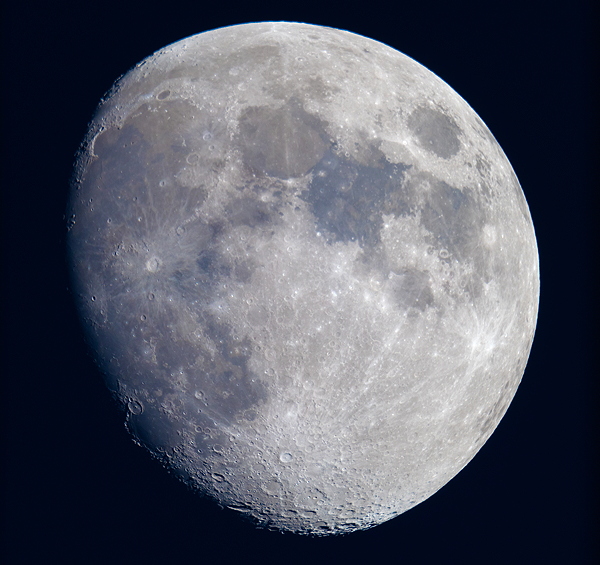More Weather; More Tele Vue 4X Powermate tests
Posted: 24 July 2018
Wednesday, 18 July 2018, was clear at sunrise but clouds returned mid-day. Thursday, 19 July, was mostly clear at sunrise, but as the day went on the clouds increased. There were some nice mammatus clouds overhead mid-afternoon as seen in this iPhone 8 Plus photo:

And a nice thunderstorm buildup to the southeast with the near First Quarter Moon:

Within an hour of the above photo the storm had grown and the sky was mostly overcast.
This iPad Pro photo was taken shortly after sunset:

Friday, 20 July, dawned mostly clear, but with a forecast of increasing clouds by evening. By early afternoon the sky was overcast with thunderstorms in the area. Received 0.008" rain on Friday. Early Saturday morning, 21 July, a storm came through (but no rain) with a lot of lightning that was captured by my webcams:
 |
 |
 |
The sky was mostly clear by mid-morning, and stayed mostly clear during the day, giving some hope that the evening would be clear enough to open the observatory. However, as sunset approached the sky became mostly cloudy.
Sunday, 22 July, dawned mostly clear, with a clear sky forecast for that night as our Monsoon Season took a break. As I was planning the night's activities late Sunday afternoon, clouds in the south began expanding to fill the southern sky, eventually making the sky mostly overcast. Grumble.
Monday, 23 July, began with a partly cloudy sky with clearing mid-morning. I went out to the observatory mid-morning to take some equipment photos. The outside air temperature was a little warm:

With the air conditioner ON, the temperature inside the observatory was 92°F.
All of these cloudy nights and the brightening Moon have been wreaking havoc on my deep sky object imaging plans. And of course, I have been missing out on good views of Mars (albeit dusty). So it was with some relief that the sky stayed mostly clear as sunset approached on Monday.
|
Open: Monday, 23 July 2018, 1857 MST Temperature: 91°F |
Session: 1264 Conditions: Mostly clear |
Equipment Used:
12" f/8 LX600 w/StarLock
2" 24mm UWA eyepiece
2" 4X Powermate
Camera:
iPhone 8 Plus
D850 DSLR
SYNCed the observatory clock to WWV time signals.
1904 MST: LX600 ON, StarLock OFF, High Precision OFF.
Viewed Venus, 102X and 406X. Nice views.
Took an iPhone 8 Plus afocal 406X photo of Venus for my upcoming review of the Tele Vue 4X Powermate.
Then viewed the waxing gibbous Moon while "Fly Me to the Moon" by Al Hirt was playing on my iPod inside my POD.
There were some storm clouds in the North, as seen in this Nikon D850 DSLR + 50mm lens photo:

1931 MST: sunset.
Mounted the D850 at prime focus of the 12" telescope and took this photo (cropped) of the Moon (1/320sec, ISO 400):

Thin clouds were now near the Moon.
I added the 4X Powermate and did some lunar imaging as well as Jupiter and Saturn imaging for my review.
2019 MST: ended planet imaging.
Viewed Saturn, 102X and 406X. Fairly good views considering the poor seeing (clouds).
2026 MST: viewed M64 (NGC4826, Black Eye Galaxy), 102X. I hoped to image it for my Extragalactic Supernova Project even though the sky was bright from the Moon and there were clouds near the galaxy. Mounted the D850 at prime focus and focused on the star Arcturus. Turned High Precision ON and slewed to M64. Unfortunately, it was now hidden by clouds. So I began waiting. 2046 MST: there were clouds in much of the sky now.
2049 MST: a packrat jumped up onto the POD Zenith Table. Lately I've heard one under the PZT but this was the first time I've seen one on top of the table.
2100 MST: StarLock ON (since M64 was now visible again). Unfortunately, the StarLock could not lock on to a guide star, probably due to the bright sky and the clouds. 2105 MST: StarLock OFF, High Precision OFF. Gave up on imaging the galaxy this session.
2110 MST: Mars had just risen over the hill to the southeast. Viewed Mars low and through a tree, 102X. No details visible.
2123 MST: viewed Mars, 102X and 406X. Still low. Still nothing but dust visible. Fortunately, there were no (Earth) clouds near Mars (yet).
2136 MST: Mars was now hidden by clouds (Earth's).
2145 MST: decided to give up on more viewing of Mars due to the cloudy sky.
2154 MST: LX600 OFF.
|
Close: Monday, 23 July 2018, 2205 MST Temperature: 84°F |
Session Length: 3h 08m Conditions: Mostly cloudy |
Comments are welcome using Email. Twitter users can use the button below to tweet this report to their followers. Thanks.
Cassiopeia Observatory Home Page
Copyright ©2018 Michael L. Weasner / mweasner@me.com
URL = http://www.weasner.com/co/Reports/2018/07/24/index.html
